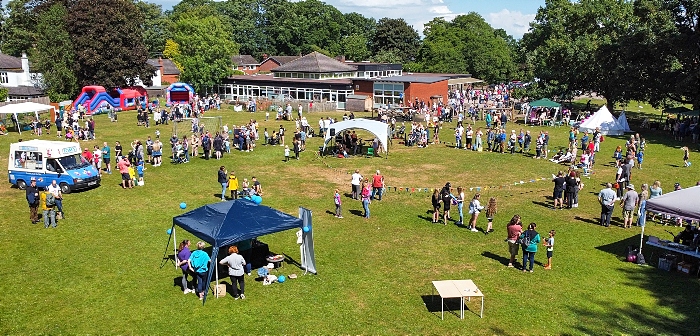
The 42nd “World Worm Charming Championships” made a welcome return to Willaston as hundreds competed for the prized trophies for the first time in three years, writes Jonathan White.
And there was an emotional return for one father and son team who attended the very first Worm Charming event 42 years ago!
John and Jago Whitehead took part back in 1980 when they travelled down from Scotland to see relatives in Willaston.
John now lives in Nantwich and Jago lives in Los Angeles in the US. But this year Jago returned, bringing along his wife Lizzy and their two-year-old son Jasper.
And due to the pandemic, it was the first time John had met his grandson.
Jago’s brother Rory and wife Summer (originally from China) and their four-year-old daughter Xuemei also took part in this year’s event, making it a memorable international family affair.
The Championship worming started at 2pm after an inspection of plots by the International Federation of Charming Worms and Allied Pastimes (IFCWAP).
Participants in each 3x3m plot had 30 minutes to charm and collect as many worms as possible.

There were ‘traditional’ plots for two adults and two children and ‘tag-team’ plots for teams who wished to change their pairings throughout the charming period.
Techniques to agitate the soil included the traditional method of vibrating a garden fork, along with alternative methods such as bouncing a football, skipping on the spot, and playing a musical instrument.
Other participants included Andrew Feltham, from Northwich, dressed as a blackbird and friend Chris White, from Wistaston, dressed as an earthworm.
Chris sang and performed on his ukulele to entice worms with ‘Green, Green Grass of Home’, ‘The Worm’, ‘There’s A Worm At The Bottom Of The Garden’, and ‘Good Vibrations’.

A news crew from German TV channel ‘RTL’ interviewed worm charming participants and visitors.
There were charity stalls, spin the wheel, tombola, coconut shy, hook-a-duck, face painting, an inflatable slide, bouncy castle and food and drink outlets.
Charities represented included Cystic Fibrosis Trust and Pawprints to Freedom. There was also a grand draw raffle and a scavenger hunt.
Year 6 Willaston Primary Academy band “Soundwave” kept the audience entertained in the arena while people awaited the results of the worm count.
Willaston Primary Academy headteacher presented the worm charming awards.
The Most Promising Beginner trophy for best newcomer was won by the Arnold family in Plot 81 with 10 worms.
The Heaviest Worm trophy was won by the Macpherson family with a worm that weighed 8 grams in Plot 140. Second place was the West family (7 grams, Plot 27) and third place was the Conroy family (5 grams, Plot 120).
The Championship trophy for Most Worms was won by the Price family in plot 129 with an impressive 83 worms given the dry weather in the week leading up to the Championship.

Second place was the Wilson family with 52 worms (Plot 70) and third place was the Brookshaw family with 49 worms (Plot 137).
The Brookshaw family won the virtual Willaston World Worm Charming Championship in 2020.
The World Worm Charming Championship was founded as a community project to raise funds for the school by Gordon Farr (former Headteacher of Willaston Primary School), John Bailey (former Deputy headteacher of Willaston Primary School), and Mike Forster (former Willaston Village Police officer).
(Images courtesy of Jonathan White)






















Recent Comments